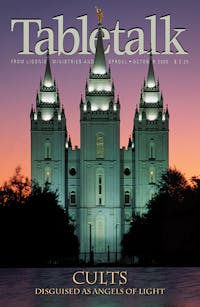
Request your free, three-month trial to Tabletalk magazine. You’ll receive the print issue monthly and gain immediate digital access to decades of archives. This trial is risk-free. No credit card required.
Try Tabletalk NowAlready receive Tabletalk magazine every month?
Verify your email address to gain unlimited access.
Writing early in the last century, J. K. Van Baalen argued that “the cults are the unpaid bills of the church.” Van Baalen’s influential work, The Chaos of the Cults, represented one of the first comprehensive efforts to evaluate the various cults of the day — Spiritism, Theosophy, Christian Science, Rosicrucianism, Swedenborgianism, Mormonism, and the Jehovah’s Witnesses, among others — from the vantage point of orthodox Christianity.
In Van Baalen’s analysis, orthodox Christianity had opened the door for the cults to proliferate throughout the culture. Sidelined by pragmatism, distracted by divisions, and committed to a “smallest common-denominator faith,” the orthodox churches had left the larger culture, and even some of their own members, unprepared to meet the challenge of the cults.
If anything, the problem is more acute in our own day. The seductions of postmodernism and the complexities of a pluralistic culture compound the difficulty involved in engaging, understanding, and confronting the cults.
In one sense, the rise of religious cults is nothing new. The religious pluralism confronted by the apostle Paul at Mars Hill must have represented something like a foreshadowing of postmodern America. This nation’s experiment in religious liberty provided cults with a safe environment for growth even as the spent emotionalism of American revivalism left a vacuum the cults were only too willing to fill. Writing in the 1920s, Charles W. Ferguson described the United States as “overrun with messiahs.”
These new religious movements attracted both sociological and political attention. Walter R. Martin, whose book, The Kingdom of the Cults, became an evangelical classic, resisted the temptation to reduce the challenge of the cults to sociology. His particular concern was with those cults that, while deviating from historic Christianity, nonetheless insisted “that they are entitled to be classified as Christians.” Martin would cite Professor Lee Belford of New York University as stating, “The problem is essentially theological where the cults are concerned. The answer of the Church must be theological and doctrinal. No sociological or cultural evaluation will do.”
Confronted by the challenges of the Enlightenment and its aftermath, many Christian denominations appeared confused and defensive about Christianity’s most crucial truth claims. Troubled by questions such as the faith of the unevangelized, the doctrine of predestination, and the anticipation of hell, many Christian churches appeared to lack confidence in biblical doctrines. Beyond this, the existence of rival Christian denominations, focused on debates over what some consider to be secondary issues, left the ground open for movements such as Mormonism to step in and claim to resolve those vexing difficulties.
Inevitably, any Christian defense had to be rooted in biblical authority. The distinctive Christian revelation claim required orthodox believers to look backward into a distant past in order to define and defend Christianity. As a restoration movement, Joseph Smith and the Mormons claimed to speak with the authority of living apostolic witnesses whose experience was presumably far closer to that of contemporary Americans.
Against the Christian doctrine of salvation through faith in Christ alone, Mormonism promoted a form of universalism. According to Joseph Smith and later Mormon teachers, hell would be inhabited only by a few “sons of perdition” who had obstinately rejected the light of Mormon doctrine. While orthodox Christians faced the difficult question of unevangelized persons, Mormonism assured the public that almost all persons would find some place in paradise.
In other words, the Mormons capitalized on perceived doctrinal difficulties even as many Christian churches appeared to be befuddled, perplexed, or unwilling to confront the challenges. Confused by the emotional excesses of revivalism, many Americans saw Mormonism as an intellectually satisfying alternative to orthodox Christianity. Moreover, the Mormons were able to promote their system as an updating of Christianity for a new age — complete with a new book and new ecclesiastical authorities.
This serves to remind contemporary Christians that J. K. Van Baalen was right — the cults are “the unpaid bills of the church.” Churches that surrender in the face of philosophical challenges, that reduce their doctrinal substance to minimal doctrines, and that fail to offer substantial theological arguments grounded in Scripture, leave their own members in a state of vulnerability to the cults and their arguments. Theological immaturity and doctrinal ambiguity represent an open invitation for cults old and new to proliferate.
Moreover, when Christians appear befuddled, embarrassed, or inept in the defense of the faith, the Church’s witness is inevitably weakened. These “unpaid bills” demand to be paid.
